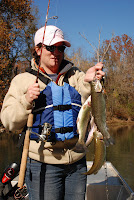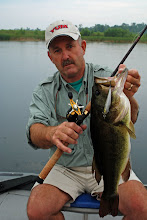



Bill Cooper 11/07
Deer hunting one of southern Missouri’s vast wilderness areas has long been on my list of outdoor adventures to do. Last season I scratched that one off of my list. However, I added that adventure to the list again. Deer hunting in the Irish Wilderness proved to be an adventure that my wife, Dian, and I will long remember.
At a foreboding 16,500 acres, the Irish Wilderness is the largest in Missouri. It is a rugged, forlorn place where an individual can still get lost if attention is not paid to detail.
The Irish carries an aura of mysticism that makes it attractive to the adventure seeking outdoorsman. Former State park Director and wilderness advocate John Karel made this observation: “Solitary hikers report that powerful spirits inhabit the Irish Wilderness. It is claimed that these relate somehow to the moody water of the Eleven Point River on the west, to the shadow of the furtive animals only barely sensed, to the glimpse of swaying ridgetop pines in a gray November bluster, or even the lingering wraiths of Indian and Irish hunters.”
The rugged, natural splendor of the Irish Wilderness, mixed with the haunting history of the area, alerts the superstitious senses of even the most experienced backcountry travelers. Add the fact that the area more than likely still looks like it did when the Osage Indians hunted there, and you have the perfect makings for a for a hair raising, watch your back kind of hunting trip.
A Catholic priest named Father John J. Hogan and his Irish immigrants were the first recorded settlers in the wilderness in 1859. Father Hogan spoke of the attractiveness of the area: “The quiet solitariness of the place seemed to inspire devotion. Nowhere could the human soul so profoundly worship as in the depths of that leafy forest, beneath the swaying branches of the lofty oaks and pines, where solitude and the heart of man united in praise and wonder of the Great creator.”
Father Hogan hoped to provide the security of family life for the Irish immigrants who had faced so many hardships in the new world. Unfortunately, the very place that provided solitude and spiritual freedom, turned against the colony with the advent of the Civil War. Father Hogan reasoned that his parishioners would be safe in the “no mans land’ of the wilderness. Indeed, the great armies of the north and south skirted the edges of the vast wilderness, but bushwhackers and murderers, who had no allegiance to any army, found the security of the rugged terrain to be to their advantage. Civilians fell easy prey to the brutal, bloody and relentless attacks of renegade marauders.
Records only indicate that there was a settlement in the wilderness prior to the Civil War and that there was not after the war. What really happened to the settlers? Did they fall prey to the bushwhackers, or did the evil spirits of the Irish Wilderness overtake them? Those who travel the bowels of the area today, keep the remembrances of the Irish immigrants fresh in their minds.
Father Hogan went on to a distinguished career as Bishop of Kansas City, but he left no record of the fate of his Irish Wilderness congregation.
Dian peered at the towering bluffs along the Eleven Point River as I motored the boat downstream along the western border of the Irish Wilderness. A shiver ran down my spine and the hair stood up on the back of my neck as I, too, looked over the vast territory of the wilderness. A sense of the presence of ‘something else’ weighed on my mind as I continued downstream. The expression on Dian’s face indicated the sense as well.
We pitched a very comfortable camp on the riverbank, at the edge of the wilderness. The murmuring river provided a sense of security from the unknowns of the interior.
Just a month earlier, in October, I had spent a week on the river, camped in the same spot. I enjoyed several days of fishing, turkey hunting and exploring the Irish Wilderness. My discovery of a mile long scrape line atop a magnificent ridge, deep in the wilderness, and spotting of an enormous wilderness buck, had prompted my return.
Satisfied with our camp home for the next few days, Dian and I pushed off in the boat to fish for the afternoon. The Eleven Point is home to Rainbow trout, smallmouth and largemouth bass, goggle-eye, chain pickerel, and walleye. We had our hearts set on a trout dinner. Too, Dian wanted to catch her first chain pickerel.
We accomplished both feats. Too, Dian managed to catch a 22-inch pickerel, the largest I had ever seen, until I caught a 28-incher ten minutes later. It could have been a state record fish. However, I am not into records and was not about to take off of the river, and travel to Alton to have the fish officially weighed. My time on the river was more important.
Friday morning, before the Saturday opener of deer season, Dian and I enjoyed a sumptuous breakfast of cinnamon apple pancakes, piled high with whipped cream, bacon, and steaming cups of coffee. I kicked the fire and we settled back into our camp chairs for awhile to enjoy the sights and the sounds of the river and to discuss our plans for the next morning’s hunt.
Dian winced as I pointed out on the map where I had seen both the big buck and his scrape line a month earlier. “That looks steep and rough,” she said.
“That is why that buck has grown to old age,” I responded.
We packed water bottles and a few snacks, along with map and compass into a daypack and headed out. The wild canebrakes, found in the rich river bottom soils, quickly enveloped us. I told Dian stories about wild razorback hogs as we walked the narrow trail leading to a nearby ridge. The feeling that something watched us put the hair on my neck to full alert. Dian stayed on my heels.
Upon breaking out of the canebreak, we faced a long slope of softball size rock rubble covered with slippery moss. At least we could see well ahead through the canopy of overhead oaks.
Shortly, we broke into an open flat, commonly called a bench in the Ozarks. We paused to catch our breath and take a sip of water. Sweat trickled down my back.
After our break, we headed up hill towards rock formations that resembled the rimrock of the box canyons out west. It was as if Mother Nature threw up a barrier to keep us out of the interior of the wilderness.
We found a path through the rock wall and continued uphill. The terrain became steeper. Every 50-yards we pause to catch our breath again. My lungs and legs burned. Dian’s cheeks blushed with color. “This is rough,” she commented. “But, gosh, isn’t it just breathtaking.”
I knew what she meant.
Forty minutes after beginning our ascent, we cleared the last little rise and broke out onto the broad, flat top of an ancient ridge. Massive white oaks, which had escaped the saw and axe because of the rugged terrain, blanketed an open park like area. We could see to the south for what seemed like forever. We stood a long time, inspired, staring at the scene before us. We were not alone.
I topped the crest of the ridge and dropped a few feet over the north side. I immediately found the scrape line I had discovered in October. I could see the next scrape, less than 30-yards away. Both scrapes approached the size of a car hood. The big buck still carried on his mission.
Dian and I backed off the line, but continued our hike along the spine of the ridge. We paused often to take in another angle of the view to the south.
A half mile down the ridge, we came to another ridge than connected from the north. Straight ahead, to the east, the main ridge dipped into a saddle. “Wow, this is a perfect setup spot for tomorrow morning,” I stated. “Every deer traveling these ridges will most likely pass this point sometime during the day.”
After crossing the saddle, we hiked another half mile. The terrain broke into a broad flat covered with white oak and post oak. It too, appeared to be a perfect spot to set up for a morning of deer hunting. However, a glimpse at the map indicated that we were well over two miles from camp. We decided then and there that we would hunt the first spot where the ridge intersected from the north.
The next morning, a noticeable chill hung over our river bottom camp. Coffee went down
easily. We opted to skip breakfast because of the hard climb ahead of us. We would snack on fruit and food bars once we settled in on top.
The climb seemed a little easier. Perhaps our excitement pumped an extra shot of adrenalin into our systems.
Daylight approached as we arrived at the junction of our ridge and the north ridge. We selected the largest white oak on the ridge as our stand site. Dian was along to watch. She had never deer hunted.
I brushed the leaves away from the base of the colossal white oak and we made ourselves comfortable. We commented again about the beauty of this spectacular place.
In less than three minutes, Dian said, “Do you hear that? Something is coming.”
I saw the unmistakable form of a pursued doe before I heard it. The panting doe ran up to within 15 feet of us and paused to look over her back. “Shoot it, “Dian advised. “ You have a doe tag, too.”
I paused. The doe bounded away. “Hear that?” Dian queried. “It’s a buck grunting like a pig.
As I readied my rifle, the buck crossed the saddle to the east with its nose to the ground.
A ray of light gleamed from its polished antlers.
When the buck reached 30 yards, I grunted with my voice. The buck never paused. At 25 yards, I yelled. The buck froze. I could see through the scope that it was not the monster, but it appeared to be a respectable 8-pointer. I squeezed the trigger.
“You dropped him in his tracks,” Dian yelled.
Upon reaching the downed buck, I frowned. “What’s wrong?” Dian asked.
“Look,” I said. “It has points broken off. My Eleven Point 8-pointer is only a 5-pointer.
Our hunt had only lasted 10 minutes. After field dressing the buck and pausing for a last look to the south, I hooked up the drag harness and began sliding the buck across the deep leaves towards camp. Shortly, I dropped off the side of the ridge. The deer slid easily down hill. I crossed a small flat to a creek that ran to the Eleven Point. I had parked our jetboat there before climbing the ridge. Hauling my buck back to camp by boat worked out much better than dragging.
As we unloaded the buck at camp, Dian asked, “Do you get the feeling we are not alone?”
“Everyone who comes here feels that way,” I offered. “Spirits, my dear, spirits of the Irish Wilderness.”

Captivating story Bill, it definitely sold me on the Irish Wilderness. Ill be there this coming spring!
ReplyDeleteWhere abouts were camping on the Eleven Point?
ReplyDelete